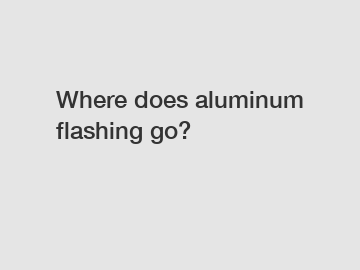Where Does Aluminum Flashing Go?
Aluminum flashing is a versatile material used in various construction projects. It is commonly used to protect buildings from water damage by redirecting water away from vulnerable areas. Flashing is typically installed in areas where two different surfaces meet, such as roofs, chimneys, windows, and doors. Understanding where aluminum flashing goes and its importance in construction can help homeowners and contractors make informed decisions about its installation.
Roof Flashing.

One of the primary purposes of aluminum flashing is to protect the roof from water penetration. Roof flashing is installed around chimneys, skylights, vents, and other roof protrusions. It creates a watertight barrier and prevents water from seeping into the roof structure, causing leaks and potential structural damage. Properly installed roof flashing ensures the longevity and durability of the roof.
Chimney Flashing.
Chimney flashing is an essential component of any chimney installation. It prevents water from seeping into the gaps between the chimney and the roof. Without flashing, water can enter the house, leading to costly repairs and potential health hazards like mold growth. The flashing is typically made up of multiple layers, including a base flashing that lies against the chimney and step flashing that overlaps with the roof shingles.
Window and Door Flashing.
Flashing around windows and doors is crucial to prevent water infiltration and subsequent water damage. Window and door flashing typically consist of a metal or rubber membrane that directs water away from the window or door frame. It ensures that water does not penetrate the building envelope and protects against rot, mold, and structural problems. Proper installation of flashing during window and door installation is essential for maintaining the integrity of the building.
Gutter Flashing.
Gutters play a vital role in protecting the building's foundation and preventing water damage. Aluminum flashing is often used at the edge of the roofline to direct water into the gutters. By providing a seamless transition from the roof to the gutters, flashing prevents water from flowing behind or under the gutters, which can lead to water damage and erosion around the foundation.
Skylight Flashing.
Skylights are a popular choice for bringing natural light into a room. However, without proper flashing, skylights can become a source of water leaks. Flashing around skylights is essential to create a watertight seal and prevent water from seeping into the gaps between the skylight and the roof. Skylight flashing is typically made of aluminum or other weather-resistant materials to ensure durability and effectiveness.
Closing Paragraph:
In conclusion, aluminum flashing plays a vital role in protecting buildings from water damage by directing water away from vulnerable areas. Whether it's roof flashing, chimney flashing, window and door flashing, gutter flashing, or skylight flashing, each installation is essential for maintaining the structural integrity of the building. If you require assistance with aluminum flashing installation or have any questions, please feel free to contact us. Our team of experts is available to help you with all your construction needs.
(Contact us to find out more about aluminum flashing installation or to get expert advice on all your construction needs.).
If you want to learn more, please visit our website aluminum roof coil, pupa coating on aluminium, Aluminium Coil for Ceilings .



Comments
Please Join Us to post.
0